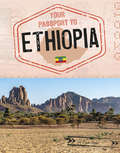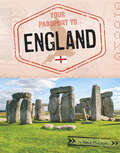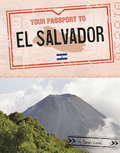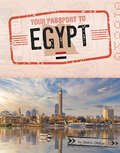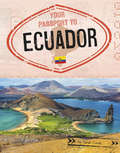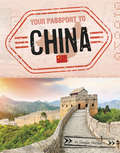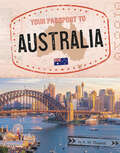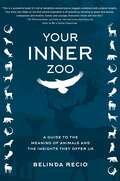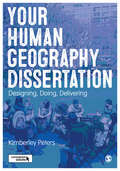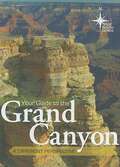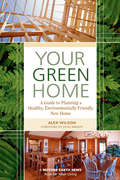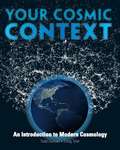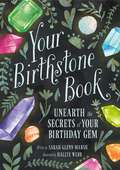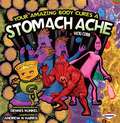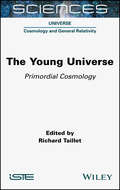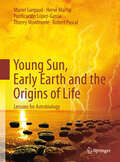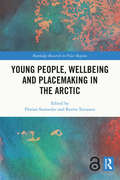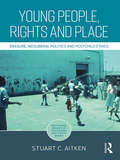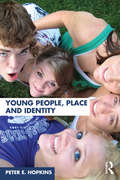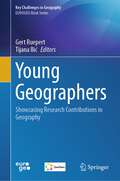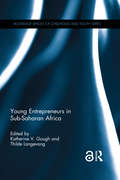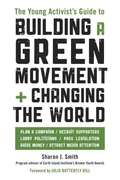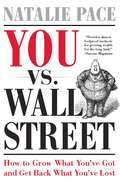- Table View
- List View
Your Passport to Ethiopia (World Passport)
by Ryan GaleWhat would it be like to live in Ethiopia? How is Ethiopia's culture unique? Explore the sights, traditions, and daily lives of Ethiopians!
Your Passport to England (World Passport)
by Nancy DickmannWhat is it like to live in or visit England? What makes England’s culture unique? Explore the geography, traditions, and daily lives of England's people.
Your Passport to El Salvador (World Passport)
by Sarah CordsWhat would it be like to live in El Salvador? How is El Salvador's culture unique? Explore the sights, traditions, and daily lives of El Salvadorians!
Your Passport to Egypt (World Passport)
by Golriz GolkarWhat is it like to live in or visit Egypt? What makes Egypt’s culture unique? Explore the geography, traditions, and daily lives of Egyptian people.
Your Passport to Ecuador (World Passport)
by Sarah CordsWhat would it be like to live in Ecuador? How is Ecuador's culture unique? Explore the sights, traditions, and daily lives of Ecuadorians!
Your Passport to China (World Passport)
by Douglas HustadWhat would it be like to live in China? How is China's culture unique? Explore the sights, traditions, and daily lives of the Chinese!
Your Passport to Australia (World Passport)
by A.M. ReynoldsWhat is it like to live in or visit Australia? What makes Australia’s culture unique? Explore the geography, traditions, and daily lives of Australian people.
Your Inner Zoo: A Guide to the Meaning of Animals and the Insights They Offer Us
by Belinda RecioWhat might we learn about our own human natures from the friskiness of a young goat, the focus of a hawk, the transformation of a butterfly, or the hibernation of a bear? How can animals—through their natural and cultural histories—offer us ideas that could help us better understand ourselves, navigate a relationship, or change an aspect of our lives? Do the animals that we admire or fear reveal something about us? What about the animals who appear in our dreams, visions, and creative inspirations? These are some of the questions addressed in The Inner Zoo: A Field Guide to the Meaning of Animals & the Insights They Offer Us. You can use The Inner Zoo: • to explore yourself through animals • to approach animals as teachers and guides • to explore the possible meaning of animal encounters • to connect with animals through their natural and cultural histories • as an animal symbolism dictionary • as an idea generator and creativity tool By exploring animal biology and behavior, as well as the cultural roles that animals play in symbolism, mythology, and traditions, The Inner Zoo invites you to approach animals as a source of provocative ideas that can lead to self-discovery and a deeper sense of connection with the more-than-human world.
Your Human Geography Dissertation: Designing, Doing, Delivering
by Kimberley PetersAn undergraduate dissertation is your opportunity to engage with geographical research, first-hand. But completing a student project can be a stressful and complex process. Your Human Geography Dissertation breaks the task down into three helpful stages: Designing: Deciding on your approach, your topic and your research question, and ensuring your project is feasible Doing: Situating your research and selecting the best methods for your dissertation project Delivering: Dealing with data and writing up your findings With information and task boxes, soundbites offering student insight and guidance, and links to online materials, this book offers a complete and accessible overview of the key skills needed to prepare, research, and write a successful human geography dissertation.
Your Human Geography Dissertation: Designing, Doing, Delivering
by Kimberley PetersAn undergraduate dissertation is your opportunity to engage with geographical research, first-hand. But completing a student project can be a stressful and complex process. Your Human Geography Dissertation breaks the task down into three helpful stages: Designing: Deciding on your approach, your topic and your research question, and ensuring your project is feasible Doing: Situating your research and selecting the best methods for your dissertation project Delivering: Dealing with data and writing up your findings With information and task boxes, soundbites offering student insight and guidance, and links to online materials, this book offers a complete and accessible overview of the key skills needed to prepare, research, and write a successful human geography dissertation.
Your Guide to the Grand Canyon: A Different Perspective (True North Series)
by Tom Vail Michael Oard Dennis Bokovoy John HergenratherExploring the Grand Canyon is a one-of-a-kind adventure. It is a World Heritage Site and one of the most amazing features on the face of the planet. The size and majesty of the Canyon is overwhelming, regardless of how many times you have viewed it, how many trails you have hiked, or how many river miles you have traveled. It is also a mystery! <p><p> Most will agree that the Grand Canyon was carved by water. But how and when is where the mystery lies. Was it formed slowly over millions of years or quickly in a catastrophic event? This debate falls into two camps, which hold to vastly divergent worldviews. This True North Guide examines the geological and ecological evidence and lets you decide which of those worldviews is best supported by the data.
Your Green Home: A Guide to Planning a Healthy, Environmentally Friendly, New Home (Mother Earth News Books for Wiser Living)
by Alex WilsonMore and more homeowners today want houses that are healthy to live in and cause minimal damage to the environment. That's what green building is all about.Your Green Home is written for homeowners planning a new home--whether you are working with an architect or builder, or serving as your own general contractor. Intended to improve the overall environmental performance of new houses being built, the book sets out to answer some of the big-picture questions relating to having a home designed and built--and getting what you want.Your Green Home covers: * Home location and its relationship to the community * Site design * Construction systems * Building design to optimize energy performance * Renewable energy systems * Material selection * Indoor environmental quality * Water efficiency * Material selectionWritten by the founder of BuildingGreen--North America's premier green building authority--this book will prove useful not only to future homeowners, but also to designers and builders seeking to meet this demand. Building professionals well-versed in green building may find this a useful book to give to potential clients to convey the scope and principles of green building.Alex Wilson is president of BuildingGreen, Inc. and executive editor of Environmental Building News, the oldest and most respected publication serving North America's green building industry. A green building expert since the 1970s, he has authored countless articles on the topic and several books, including Green Building Products, the Consumer Guide to Home Energy Savings, and Green Development: Integrating Ecology and Real Estate.
Your Cosmic Context: An Introduction to Modern Cosmology
by Todd Duncan Craig TylerYour Cosmic Context provides a framework for exploring the nature and history of our universe. Equally well suited for independent reading and study or for a one-term general education course in cosmology, this book is a guide to the key insights of scientific cosmology, including the big bang theory and exotic entities like dark matter and dark energy. It also explains how we discovered the surprising things we now know about the distant reaches of space and time, and thereby serves as one of the best available illustrations of the scientific method in action.
Your Birthstone Book: Unearth the Secrets of Your Birthday Gem
by Sarah Glenn MarshLearn the amazing (and sometimes magical) history of gemstones from around the world through the corresponding birthstones that represent each month of the year.Gemstones are among Earth&’s rarest and most beautiful creations. They are history&’s preeminent symbols of wealth and power. They are valued because they are beautiful and rare, but also because their beauty is undiminished with time. The stone that once adorned a king or maharaja, might today be set in a ring or necklace, and if not destroyed, will continue to sparkle thousands of years from now. This history only increases the value of these stones.What better way to teach young readers about gemstones than by focusing on the different birthstones that correspond to each month of the year? Everyone (mostly) knows their birthstone. But do they know the full history of these stones--where they were mined, how/why they were popular, or how to best harness a stone's energy to help deal with matters of friendship, family, and life? Your Birthstone Book will give readers insight into the powers assigned different bithstones while exploring their fascinating uses over the course of history.
Your Amazing Body Cures a Stomach Ache
by Vicki CobbMeet your personal superheroes - your body's cells! Superhero cells rally together to battle common childhood ailments in this series in which Vicki Cobb explains how your amazing human body heals itself and fights off intruders.
The Young Universe: Primordial Cosmology
by Richard TailletThe Young Universe presents four major physical and astrophysical themes related to these extreme phases of the primordial universe. In particular, it presents the physics of the primordial plasma and the concepts of quantum and particle physics necessary to describe this extreme state.It discusses the cosmological background radiation and explores inflation, an extremely rapid expansion phase that is believed to have occurred very early in cosmological history and to have shaped our present universe. The book also provides a synthesis of the dark matter problem.
Young Sun, Early Earth and the Origins of Life
by Hervé Martin Muriel Gargaud Purificación López-García Robert Pascal Storm Dunlop Thierry Montmerle- How did the Sun come into existence? - How was the Earth formed? - How long has Earth been the way it is now, with its combination of oceans and continents? - How do you define "life"? - How did the first life forms emerge? - What conditions made it possible for living things to evolve? All these questions are answered in this colourful textbook addressing undergraduate students in "Origins of Life" courses and the scientifically interested public. The authors take the reader on an amazing voyage through time, beginning five thousand million years ago in a cloud of interstellar dust and ending five hundred million years ago, when the living world that we see today was finally formed. A chapter on exoplanets provides an overview of the search for planets outside the solar system, especially for habitable ones. The appendix closes the book with a glossary, a bibliography of further readings and a summary of the Origins of the Earth and life in fourteen boxes.
Young People, Wellbeing and Sustainable Arctic Communities (Routledge Research in Polar Regions)
by Stammler Florian Toivanen ReettaYouth are usually not (yet) decision makers in politics or in business corporations, but the sustainability of Arctic settlements depends on whether or not youth envision such places as offering opportunities for a good future. This is the first multidisciplinary volume presenting original research on Arctic youth. This edited book presents the results of two research projects on youth wellbeing and senses of place in the Arctic region. The contributions are united by their focus on agency. Rather than seeing youth as vulnerable and possible victims of decisions by others, they illustrate the diverse avenues that youth pursue to achieve a good life in the Arctic. The contributions also show which social, economic, political and legal conditions provide the best frame for youth agency in Arctic settlements. Rather than portraying the Arctic as a resource frontier, a hotspot for climate change and a place where biodiversity and traditional Indigenous cultures are under threat, the book introduces the Arctic as a place for opportunities, the realization of life trajectories and young people’s images of home. Rooted in anthropology, the chapters also feature contributions from the fields of sociology, geography, sustainability science, legal studies and political science. This book is intended for an audience interested in anthropology, political science, Arctic urban studies, youth studies, Arctic social sciences and humanities in general. It would attract those working on Arctic sustainability, wellbeing in the Arctic, Arctic demography and overall wellbeing of youth.
Young People, Rights and Place: Erasure, Neoliberal Politics and Postchild Ethics (Routledge Spaces of Childhood and Youth Series)
by Stuart C. AitkenConcern is growing about children’s rights and the curtailment of those rights through the excesses of neoliberal governance. This book discusses children’s spatial and citizenship rights, and the ways young people and their families push against diminished rights. Armed initially with theoretical concerns about the construction of children through the political status quo and the ways youth rights are spatially segregated, the book begins with a disarmingly simple supposition: Young people have the right to make and remake their spaces and, as a consequence, themselves. This book de-centers monadic ideas of children in favor of a post-humanist perspective, which embraces the radical relationality of children as more-than-children/more-than-human. Its empirical focus begins with the struggles of Slovenian Izbrisani (‘erased’) youth from 1992 to the present day and reaches out to child rights and youth activists elsewhere in the world with examples from South America, Eastern Europe and the USA. The author argues that universal child rights have not worked and pushes for a more radical, sustainable ethics, which dares to admit that children’s humanity is something more than we, as adults, can imagine. Chapters in this groundbreaking contribution will be of interest to students, researchers and practitioners in the social sciences, humanities and public policy.
Young People, Place and Identity
by Peter E. HopkinsYoung People, Place and Identity offers a series of rich insights into young people’s everyday lives. What places do young people engage with on a daily basis? How do they use these places? How do their identities influence these contexts? By working through common-sense understandings of young people’s behaviours and the places they occupy, the author seeks to answer these and other questions. In doing so the book challenges and re-shapes understandings of young people’s relationships with different places and identities. The textbook is one of the first books to map out the scales, themes and sites engaged with by young people on a daily basis as they construct their multiple identities. The scales explored here include the body, neighbourhood and community, mobilities and transitions and urban-rural settings and how these all shape and are shaped by young people’s identities. Each chapter explores how social identities (such as race, gender, sexuality, class, disability and religion) are constructed within particular contexts and influenced by multiple processes of inclusion and exclusion. These discussions are supported by details of the research methods and ethical issues involved in researching young people’s lives. Drawing upon research from a range of contexts, including Europe, North America and Australasia, this book demonstrates the complex ways in which young people creatively shape, contest and resist their engagements with different places and identities. The range of issues, topics and case studies explored include: ethical and methodological issues in youth research; youth subcultures; experiences of home; territorialism; youth and crime; political engagement and participation; responses to global issues; engagements with different institutional contexts; negotiating public space; the transition to adulthood; drinking cultures. The author explores these issues through blending together original empirical research, theory and policy. Individual chapters are supported by key themes, project ideas and suggested further reading. Details of key authors, journals and research centres and organisations are also included at the end of the book. This textbook will be pertinent for undergraduate and postgraduate students and academic researchers interested in better understanding the relationships between young people, places and identities.
Young Geographers: Showcasing Research Contributions in Geography (Key Challenges in Geography)
by Gert Ruepert Tijana IlićThis book shows an updated overview of research about human geography topics like urban growth/urban challenges, transportation, landscape, land cover, geospatial analysis, regional planning/local development, cultural geography, tourism, and so on. Between 2020 and 2022, due to COVID-19 and lockdowns worldwide, there were fewer opportunities for young and upcoming researchers to present their state-of-the-art findings at conferences. In order to highlight exceptional research of young geographers during this time, the idea for this book was created. In collaboration with the EGEA alumni foundation for students and young geographers, 12 authors were selected to showcase their scientific work. In addition to that, most of them present amazing maps and figures as outstanding expression of the need of GIS for geography research.
Young Entrepreneurs in Sub-Saharan Africa (Routledge Spaces of Childhood and Youth Series)
by Katherine V. Gough Thilde LangevangYoung people in sub-Saharan Africa are growing up in rapidly changing social and economic environments which produce high levels of un- and underemployment. Job creation through entrepreneurship is currently being promoted by international organizations, governments and NGOs as a key solution, despite there being a dearth of knowledge about youth entrepreneurship in an African context. This book makes an important contribution by exploring the nature of youth entrepreneurship in Ghana, Uganda and Zambia. It provides new insights into conceptual and methodological discussions of youth entrepreneurship as well as presenting original empirical data. Drawing on quantitative and qualitative research, conducted under the auspices of a collaborative, interdisciplinary and comparative research project, it highlights the opportunities and challenges young people face in setting up and running businesses. Divided into a number of clear sections, each with its own introduction and conclusion, the book considers the nature of youth entrepreneurship at the national level, in both urban and rural areas, in specific sectors - including mobile telephony, mining, handicrafts and tourism - and analyses how key factors, such as microfinance, social capital and entrepreneurship education, affect youth entrepreneurship. New light is shed on the multi-faceted nature of youth entrepreneurship and a convincing case is presented for a more nuanced understanding of the term entrepreneurship and the situation faced by many African youth today. This book will be of interest to a wide range of scholars interested in youth entrepreneurship, including in development studies, business studies, youth studies and geography, as well as to development practitioners and policy makers. The Open Access title has now been added to the Open Access page. http://www.tandfebooks.com/page/openaccess
Young Children and the Environment
by Julie M. DavisYoung Children and the Environment tackles one of the biggest contemporary issues of our times - the changing environment - and demonstrates how early education can contribute to sustainable living. An essential text for students in early childhood education and a practical resource for child care practitioners and primary school teachers, it is designed to promote education for sustainability from birth to 8 years. The text refers to national and international initiatives such as 'Sustainable Schools', 'Child Friendly Cities', and 'Health Promoting Schools' and explores their existing and potential links with early childhood education. Groundbreaking content draws on recent literature in the areas of organisational, educational and cultural change and environmental sustainability. Early childhood case studies and vignettes exemplify leadership in practice, and 'Provocations' are integrated throughout to inspire new ways of thinking about the environment, the wider world, young children and the transformative power of early education.
The Young Activist's Guide to Building a Green Movement + Changing the World
by Sharon J. SmithIf you want to make a significant and sustainable impact on the health of our planet, this powerful and practical guide can help. Author and activist Sharon J. Smith shares proven strategies and lessons learned from the winners of Earth Island Institute#x19;s Brower Youth Awards-America#x19;s top honor for young green leaders. Here are all the tools you need-from planning a campaign and recruiting supporters to raising money and attracting media attention-to turn your ideas into actions and make changes that matter. All author proceeds from the sale of this book go to Earth Island Institute#x19;s Brower Youth Awards to support the next generation of young activists.
You vs. Wall Street
by Natalie PaceNatalie Pace uses her unique personal story to show readers how they too can win big on Wall Street while staying true to their hearts.
